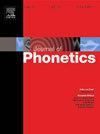Normalization, essentialization, and the erasure of social and linguistic variation
IF 1.9
1区 文学
0 LANGUAGE & LINGUISTICS
引用次数: 0
Abstract
Linguists investigating the phonetic properties of vowels, e.g. height and frontness, often use normalization algorithms to remove ‘irrelevant’ variation from vowel formant data. The current conception and evaluation of these algorithms focuses on phonemic classification and the removal of ‘anatomical’ variation, an approach which suggests an essentialist perspective on linguistic variation and leads to the erasure and underreporting of linguistic and social information. Instead, it is suggested that for many purposes, researchers need algorithms that correctly represent phonetic information by removing only non-phonetic formant variation. Acoustic variation that does not affect phonetic properties is non-phonetic, making it ‘transparent’ to the linguistic system and incapable of communicating linguistic contrast. Evidence is presented that only the uniform scaling of formant patterns appears to be non-phonetic, indicating that uniform scaling normalization algorithms should be preferred. Finally, given that phonetic properties are products of human psychology that enter into experience only through perception, it is argued that the normalization algorithms used by phoneticians and sociolinguists should be thought of as models of human perception. The change to a perceptual and phonetic, rather than anatomical and phonemic, approach to normalization will promote more reliable and theoretically sound research outcomes, and better aligns with linguistic theory.
正常化,本质化,以及消除社会和语言的差异
语言学家研究元音的语音特性,例如高度和正面,经常使用规范化算法从元音形成体数据中去除“不相关”的变化。目前对这些算法的概念和评估侧重于音位分类和消除“解剖”变异,这种方法提出了语言变异的本质主义观点,并导致语言和社会信息的抹除和少报。相反,有人建议,出于多种目的,研究人员需要通过仅去除非语音形成峰变化来正确表示语音信息的算法。不影响语音特性的声学变化是非语音的,使其对语言系统“透明”,无法传达语言对比。证据表明,只有均匀缩放的形成模式似乎是非语音的,表明均匀缩放归一化算法应该是首选。最后,考虑到语音属性是人类心理的产物,只能通过感知进入经验,有人认为语音学家和社会语言学家使用的规范化算法应该被认为是人类感知的模型。从解剖学和音位学转向感性和音位学的规范化方法,将促进更可靠和理论上健全的研究成果,并更好地符合语言学理论。
本文章由计算机程序翻译,如有差异,请以英文原文为准。
求助全文
约1分钟内获得全文
求助全文
来源期刊

Journal of Phonetics
Multiple-
CiteScore
3.50
自引率
26.30%
发文量
49
期刊介绍:
The Journal of Phonetics publishes papers of an experimental or theoretical nature that deal with phonetic aspects of language and linguistic communication processes. Papers dealing with technological and/or pathological topics, or papers of an interdisciplinary nature are also suitable, provided that linguistic-phonetic principles underlie the work reported. Regular articles, review articles, and letters to the editor are published. Themed issues are also published, devoted entirely to a specific subject of interest within the field of phonetics.
 求助内容:
求助内容: 应助结果提醒方式:
应助结果提醒方式:


